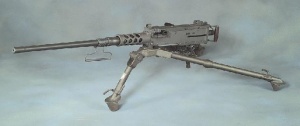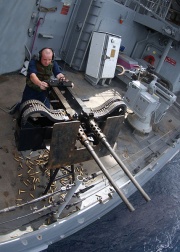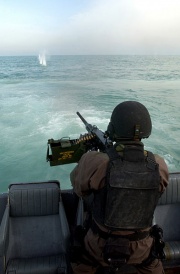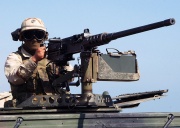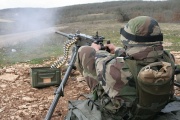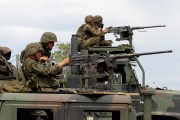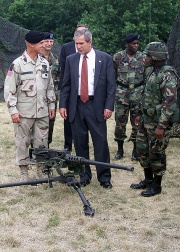M2 Browning machine gun
| |||||||||||||||||||||||||||||||||||||||||||||||||||||||||||||||||
- This article is about the .50 caliber M2 machine gun. For the .30-06 M2 machine gun, see M1919 Browning machine gun.
The M2 Machine Gun, or Browning .50 Caliber Machine Gun is a heavy machine gun designed towards the end of World War I by John Browning. It was nicknamed Ma Deuce by US troops or simply called "fifty-cal." in reference to its caliber. The design has had many specific designations; the official designation for the current infantry type is Browning Machine Gun, Cal. .50, M2, HB, Flexible. It is effective against infantry, unarmored or lightly-armored vehicles and boats, light fortifications, and low-flying aircraft.
The Browning .50 machine gun has been used extensively as a vehicle weapon and for aircraft armament by the United States from the 1920s to the present day. It was heavily used during World War II, the Korean War, the Vietnam War, as well as during operations in Iraq in the 1990s and 2000s. It is the primary heavy machine gun of NATO countries, and has been used by many other countries. It is still in use today, with only a few modern improvements. The M2 has been in use longer than any other small arm in U.S. inventory. It was very similar in design to the smaller Browning Model 1919 machine gun.
Contents |
[edit] History
Using a round originally designed by Winchester, the .50 BMG round was designed as a response to the German 13 mm anti-tank rifle of World War I and employed in a redesigned and scaled-up M1917 Browning .30 cal. machine gun. It was quickly adapted to the anti-aircraft role. It was also selected for the ground role and adopted by the U.S. as the Model 1921. The latter served during the 1920s as an anti-aircraft and anti-armor gun. In 1932, the design was updated and adopted as the M2, though fulfilling the same role. As with the M1921, the original infantry variant of the M2 was equipped with a water jacket for cooling [1]. A variant without a water jacket, but with a thicker-walled, air-cooled barrel superseded it (air-cooled barrels had already been used on variants for use on aircraft, but these quickly overheated in ground use). This new variant was then designated the M2 HB (HB for Heavy Barrel). The added mass and surface area of the new barrel compensated, somewhat, for the loss of water-cooling, while reducing bulk and weight (the M2 weighed 121 lb (55 kg), with water, whereas the M2 HB weighs 84 lbs). Due to the long procedure for changing the barrel, an improved system was developed called QCB (quick change barrel). A lightweight version, weighing 24 lb (11 kg) less—a mere 60 lb (27 kg)—was also developed.
[edit] Design details
The M2 is a scaled-up version of John Browning's M1917 .30 caliber machine gun (even using the same timing gauges), fires the .50 BMG cartridge, which today is also used in high-powered sniper rifles and long range target rifles due to its excellent long range accuracy, external ballistics performance, incredible stopping power, and lethality. The M2 is an air-cooled, belt-fed, machine gun that fires from a closed bolt, operated on the short recoil principle. In this action, the bolt and barrel are initially locked together, and recoil upon firing. After a short distance, the bolt and barrel unlock, and the bolt continues to move rearwards relative to the barrel. This action opens the bolt, and pulls the belt of ammunition through the weapon, readying it to fire again, all at a cyclic rate of 450–550 rounds per minute (600–1,200 M2/M3 in WW2 aircraft, 300 synchronized M2). This is a rate of fire not generally achieved in use, as sustained fire at that rate will "shoot out" the barrel within a few thousand rounds, necessitating replacement. The M2 machine gun's sustained rate of fire is considered to be anything less than 40 rounds per minute.
The M2 has a maximum range of 7.4 kilometers (4.55 miles) when using the M2 ball ammunition, with a maximum effective range of 1.8 kilometers (1.2 miles) when fired from the M3 tripod. In its ground-portable, crew-served role, the gun itself weighs in at a hefty 84 pounds (38 kg), and the assembled M3 tripod another 44 pounds (20 kg). In this configuration, the V-shaped "butterfly" trigger is located at the very rear of the weapon, with a "spade handle" hand-grip on either side of it and the bolt release the center. The "spade handles" are gripped and the butterfly trigger is depressed with one or both thumbs. When the bolt release is locked down by the bolt latch release lock on the buffer tube sleeve, the gun functions in fully automatic mode. Otherwise, the M2 is a single-shot weapon. Unlike virtually all other modern machine guns, it has no safety. Conversely, the bolt release can be unlocked into the up position resulting in single-shot firing (the gunner must press the bolt latch release to send the bolt forward). In either mode the gun is fired by pressing the butterfly triggers. Recently new rear buffer assemblies have used squeeze triggers mounted to the hand grips, doing away with the butterfly triggers.
Because the M2 was intentionally designed to be fit into many configurations, it can be adapted to feed from the left or right side of the weapon by exchanging the belt-holding pawls, the belt feed pawl, the front and rear cartridge stops, and reversing the bolt switch. The conversion can be completed in under a minute with no tools.
There are several different types of ammunition used in the gun including M2 Ball for personnel and light material targets, M1 tracer, and M962 SLAPT. The latter ammunition along with the M903 SLAP round can penetrate up to 3/4 inch high hard armor at 1500 meters. This is achieved by using a .30 inch diameter tungsten penetrator. The SLAPT adds a tracer charge to the base of the ammunition. This ammunition was approved for service in 1990.[3][4]
When firing blanks, a large blank-firing adapter (BFA) must be used to keep the gas pressure high enough to allow the action to cycle. The adapter is very distinctive, attaching to the muzzle with three rods extending back to the base. The BFA can often be seen on M2s during peacetime operations.
[edit] Combat use
The M2 .50 Browning machine gun has been used for various roles:
- A medium infantry support weapon
- As an anti-aircraft gun in some ships, or on the ground. The original water-cooled version of the M2 was used as an emplaced or vehicle-mounted anti-aircraft weapon on a sturdy pedestal mount. In some cases multiple air and water-cooled weapons were grouped. In some of these instances the mount featured one M2 with a left-handed feed and one with right-handed feed are paired. Four and six guns are also sometimes mounted on the same turret.
- Primary or secondary weapon on an armored fighting vehicle.
- Primary or secondary weapon on a naval patrol boat.
- Secondary weapon for anti-boat defense on large naval vessels (corvettes, frigates, destroyers, cruisers, etc).
- Coaxial gun or independent mounting in some tanks.
- Fixed-mounted primary armament in World War II-era U.S. aircraft such as the P-47 Thunderbolt, P-51 Mustang, and the Korean-era U.S. F-86 Sabre.
- Fixed or flexible-mounted defensive armament in World War II-era bombers such as the B-17 Flying Fortress, and B-24 Liberator.
[edit] United States
At the outbreak of the Second World War the United States had versions of the M2 in service primarily as fixed aircraft guns and as anti-aircraft weapons (mounted on and off a wide variety of vehicles). It was also technically still in service as an anti-tank weapon, as originally intended.[5] On most of the vehicles the weapon was mounted on it was placed in a position designed for anti-aircraft rather than any other use. Units in the field often modified the mountings on their vehicles, especially tanks and tank destroyers, to be more useful in the anti-personnel role.[6] Reports vary on its effectiveness in this role. There are instances of reports about the "essential" nature of the weapon for anti-personnel uses.[7]
[edit] Commonwealth forces
Commonwealth use of the .50 was limited in the Second World War, despite it being standard armament on US-built/designed AFVs such as the M4 Sherman or M10 Wolverine that began to see use in British, Canadian, Australian and New Zealand units from 1942 on. Commonwealth tank crew commanders more often than not deleted the .50 altogether as being of limited use, given three factors. First, the weapon was an anti-aircraft weapon, and Allied aerial superiority rendered it unnecessary. Second, in order to employ the weapon against ground targets, the commander had to exit the turret and expose himself to enemy fire. Finally, Commanders, especially in Italy, also found that the gun caught on low-hanging trees and vines and posed a danger to the crew commander's head and face.
Some US-built aircraft in Commonwealth service carried the gun, while turret-mounted .50 Brownings were used, later in the war, in such aircraft as the Lancaster bomber.
[edit] M2 as sniper rifle
The M2 machine gun has been used in a single instance as a long-range sniper rifle, when equipped with a telescopic sight. This use was discovered by US Marine sniper Carlos Hathcock during the Vietnam War. Using the Unertl scope supplied on his Winchester Model 70 .30-06 sniper rifle and a mounting bracket of his own design, Hathcock could quickly convert the M2 into a rifle that, when firing semi-automatically, could accurately hit targets at up to 2500 yards--twice the range of the Winchester sniper rifle. The success of the M2 in this role led to the development of purpose-built sniper rifles, generally bolt-action, designed to fire the same .50-caliber round.
The M2 itself had two traits that made this possible. Firstly, the M2 has a full automatic mode activated by locking down the bolt release lever between the butterfly triggers. Full automatic fire mode is achieved by rotating a snap spring on the exterior of the buffer housing to hold the bolt release down. The M2HB can be fired dependably in semi-automatic mode with the bolt release up and pressing it to load each round. A skilled gunner can fire single rounds by quickly releasing the butterflies on full automatic mode. In either mode the gun is fired by pressing the butterfly trigger. Secondly, Its traversing-and-elevating (T & E) mechanism attached to the tripod made accurate aiming possible, by turning the traversing handwheel and elevating handwheel until the target was in the sights.
[edit] Variants and derivatives
[edit] M2 variants
The basic M2 was deployed in US service in a number of subvariants, all with separate complete designations as per the US Army system. The basic designation as mentioned in the introduction is Browning Machine Gun, Cal. .50, M2, with others as described below.
The development of the M1921 water-cooled machine gun which led to the M2, meant that the initial M2s were in fact water-cooled. These weapons were designated Browning Machine Gun, Cal. .50, M2, Water-Cooled, Flexible. There was no fixed water-cooled version.
Improved air-cooled heavy barrel versions came in three subtypes. The basic infantry model, Browning Machine Gun, Cal. .50, M2, HB, Flexible, a fixed developed for use on the M6 Heavy Tank designated Browning Machine Gun, Cal. .50, M2, HB, Fixed, and a "turret type" whereby "Flexible" M2s were modified slightly for use in tank turrets. The subvariant designation Browning Machine Gun, Cal. .50, M2, HB, Turret was only used for manufacturing, supply, and administration identification and separation from flexible M2s.
A number of additional subvariants were developed after the end of the Second World War. The Caliber .50 Machine Gun, Browning, M2, Heavy Barrel, M48 Turret Type was developed for the commander's copula on the M48 Patton tank, and then later used in the commander's position on the M1 Abrams tanks. Three subvaraints were also developed for used by the US Navy on a variety of ships and watercraft. These included the Caliber .50 Machine Gun, Browning, M2, Heavy Barrel, Soft Mount (Navy) and the Caliber .50 Machine Gun, Browning, M2, Heavy Barrel, Fixed Type (Navy). The fixed types fire from a solenoid trigger and come in left or right hand feed variants for use on the Mk 56 Mod 0 dual mount and other mounts.
[edit] AN/M2, M3, XM296/M296, and GAU-10/A
The M2 machine gun was heavily used as a remote fired fixed weapon, primarily in aircraft, but also in other applications. For this a variant of the M2 was developed (sometimes seen under the designation AN/M2, but it is important to note that there were .30 and .50 caliber weapons with this designation), with the ability to fire from a solenoid trigger. For aircraft mounting some were also fitted with substantially lighter barrels, permitted by the cooling effect of air in the slip-stream. The official designation for this weapon was Browning Machine Gun, Aircraft, Cal. .50, M2 followed by either "Fixed" or Flexible" depending on whether the weapon was used as a fixed forward firing gun or for use by an airplane's crew, such as a waist gun position on a B-17.
The M3 was a more purpose built variant for remote firing use, that also featured a higher rate of fire. This weapon was used on the XM14/SUU-12/A gun pod.
The XM296/M296 is a further development of the M2/M3 machine gun for remote firing applications, and is currently only used in an armament system for to the OH-58 Kiowa Warrior helicopter. The M296 differs from previous remote firing variants primarily in the lack of bolt latch allowing for single shots.
The GAU-10/A (NSN or National Stock Number 1005-01-029-3428) has been identified as a member of the Browning M2 family through its inclusion in the June 2000 issue of Countermeasure (Vol 21, No 6, available online here). Countermeasure is published by the Army Ground Risk Management Team, and identifies important issues that soldiers should be aware of with regards to risk management and safety. Beyond this connection, there is no specific information on the GAU-10/A, and it is odd that the only online reference would be from a US Army publication as this is a USAF designation.
[edit] XM213/M213, XM218, GAU-15/A, GAU-16/A, and GAU-18/A
The XM213/M213 was a modernization and adaptation of existing .50 caliber AN/M2s in inventory for use as a pintle mounted door gun on helicopters using the M59 armament subsystem.
The GAU-15/A, formerly identified as the XM218, is a lightweight member of the M2/M3 family. The GAU-16/A was an improved GAU-15/A with modified grip and sight assemblies for similar applications. Both of these weapons were used as a part of the A/A49E-11 armament subsystem (Also known as the Defensive Armament System).
The GAU-18/A, is a lightweight variant of the M2/M3, and is used on the USAF's MH-53 Pave Low and HH-60 Pave Hawk helicopters. These weapons do not utilize the heavy barrel, and are typically set up as left-hand feed, right-hand charging weapons. In this configuration the gun is fitted with a chute adapter attached to its left hand feed pawl bracket. Thus, the weapon can receive ammunition through a feed chute system connected to internally-mounted ammunition cans. Originally designed to accommodate 1,700 rounds, these cans have since been modified due to space constraints, and now hold about half that amount. However, many aerial gunners find the chute system cumbersome, and opt to install a bracket accommodating the 100-round cans instead.
[edit] GAU-21/A and M3P
The FN produced M3 series is also in U.S. military service in two versions. One being a fixed remote firing version, the FN M3P, used on the Avenger Air Defense System. The U.S. Army would appear to use this designation for the weapon.
The M3M flexible machine gun has been adopted by the USAF and the USN under the designation GAU-21/A for pintle applications on helicopters.
[edit] M2 E-50 (M2E50)
A long overdue upgrade program for existing infantry M2s and other M2s currently in U.S. Army service, the E50 finally provides a: Quick Change Barrel (QCB) capability, a rail accessory mount, an improved flash hider and a manual safety.
The E50 designation initially appeared to be within the bounds of the normal U.S. Army designation system. However, it later turned out that the term was in fact a developmental project that stands for Enhanced 50, as in enhanced .50 caliber machine gun. Developed primarily as a conversion kit for existing weapons, it is likely that new production machine guns will be built to this standard. In later U.S. Army briefings, this variant has been referenced as the M2E2 or M2A1.
[edit] International usage
The M2 family has also been widely used abroad, primarily in its basic infantry configuration. A brief listing of foreign designations for M2 family weapons follows:
| Country | NATO Member | Designation | Description |
|---|---|---|---|
| Afghanistan | No | M2HB | 12.7 Browning Heavy Machine Gun |
| Lebanon | |||
| Argentina | No | M2HB | 12.7 × 99 mm Browning M2HB machine gun |
| Australia | No | M2HB-QCB | 12.7 × 99 mm Browning M2HB machine gun (also manufactured locally under license by ADI)[2] |
| New Zealand | No | M2HB | 12.7 × 99 mm Browning M2HB machine gun |
| Austria | No | üsMG M2 | 12.7 × 99 mm Browning M2HB machine gun |
| Belgium | Yes | FN M2HB-QCB | 12.7 × 99 mm Browning M2HB machine gun, used as infantry weapon, IFV mounted gun and as tank's AA gun |
| Bosnia-Herzegovina | No | ||
| Brazil | No | Mtr .50 M2 HB "BROWNING" | 12.7 × 99 mm Browning M2HB machine gun |
| Cambodia | No | M2, M2HB | 12.7 × 99 mm Browning M2HB machine gun |
| Canada | Yes | M2 | 12.7 × 99 mm Browning M2HB machine gun |
| Chile | No | FN M2HB-QCB | 12.7 × 99 mm Browning M2HB machine gun |
| Croatian Army | No | ||
| Denmark | Yes | M/50 TMG | 12.7 × 99 mm Browning M2HB machine gun |
| France | Yes | MIT-12,7, MIT-12,7 CRC (QCB) | 12.7 × 99 mm Browning M2HB or FN QCB |
| Germany | Yes | MG50-1, M3M | 12.7 × 99 mm Browning M2HB or M3M machine gun |
| Iceland | Yes | vélbyssa | 12.7 × 99 mm Browning M2HB machine gun |
| India | No | M2HB | 12.7 × 99 mm Browning M2HB machine gun in limited quantities |
| Israel | No | מק"כ ("MAKACH") | 12.7 × 99 mm Browning M2HB machine gun, used as infantry weapon, IFV mounted gun and as tank's coaxial gun |
| Ireland | No | Infantry Support, HMG & Air Defence. | |
| Italy | Yes | Browning M2 12.7mm | 12.7 × 99 mm Browning M2HB machine gun |
| Japan | No | 12.7 mm重機関銃M2 (Licensed by Sumitomo Heavy Industries) | 12.7 × 99 mm Browning M2HB machine gun, used as IFV mounted gun and as tank's coaxial gun |
| Malaysia | No | 12.7 mm M2HB | 12.7 × 99 mm Browning M2HB machine gun, used as helicopter's mounted gun and as tank's coaxial gun |
| Netherlands | Yes | MIT-12,7, MIT-12,7 CRC (QCB) | 12.7 × 99 mm Browning M2HB or FN QCB |
| Poland | Yes | M2HB-QCB | Used by Polish special forces |
| Portugal | Yes | Metralhadora 12,7 mm Browning m/55 | 12.7 × 99 mm Browning M2HB machine gun |
| South Africa | No | M2HB (Licensed by ARAM (Pty) Ltd) | 12.7 × 99 mm Browning M2HB machine gun |
| South Korea | No | K6 | a clone of 12.7 × 99 mm Browning M2HB QCB machine gun (manufactured by S&T Dynamics) |
| Spain | Yes | Ametralladora Pesada M-2 HB | 12.7 × 99 mm Browning M2HB machine gun |
| Norway | Yes | M/50 | 12.7 × 99 mm Browning M2HB machine gun |
| Sweden | No | Tksp 12,7 (Licensed by Bofors) | 12.7 × 99 mm Browning M2HB machine gun |
| Thailand | No | ปืนกล 93 | 12.7 × 99 mm Browning M2HB machine gun |
| United Kingdom | Yes | L2A1 | 12.7 × 99 mm Browning M2HB machine gun |
| L6, L6A1 | 12.7 × 99 mm Browning M2 HB machine gun; ranging gun for the L7 105 mm tank gun on the Centurion tank | ||
| L11, L11A1 | 12.7 × 99 mm Browning M2HB machine gun; ranging gun | ||
| L21A1 | 12.7 × 99 mm Browning M2HB machine gun; ranging gun for the 120 mm tank gun on the Chieftain tank | ||
| L111A1 | 12.7 × 99 mm Browning/FN M2HB QCB machine gun (built under license by Manroy[3]) | ||
| Switzerland | No | Mg 64 | 12.7 × 99 mm Browning M2 HB machine gun |
| Vietnam | No | M2, M2HB | 12.7 × 99 mm Browning M2HB machine gun |
[edit] Resources
| Gun Owners' Resource has the following relevant documents available for free download for the M2 Browning machine gun and/or its variants: |
- FM 23-65 BROWNING MACHINE GUN CALIBER .50 HB, M2 Headquarters, Department of the Army (US), June 1991, approved for release (9.9MB .PDF file, 246pgs)

This article is either missing some diagrams which would help to illustrate a proper breakdown of the firearm in question or the diagrams which are here are inadequate. This article could use more input to fill in the missing bits. You (yes, you!) can help Gunsopedia provide more comprehensive information to our users by using your own knowledge to add to it.
[edit] See also
- MG 131 machine gun, German rival to the M2 Browning
- XM312, 12.7 mm machine gun prototype gun based on the prototype 25 mm XM307.
- LW50MG, 12.7 mm machine gun prototype gun of a new design to replace the M2 by 2012.
- DShK, NSV & Kord 12.7mm machine guns, Soviet/Russian equivalents.
[edit] References
[edit] Citations
- ↑ See Carlos Hathcock
- ↑ Global Security website
- ↑ M903 Caliber .50 Saboted Light Armor Penetrator (SLAP), M962 Saboted Light Armor
- ↑ Caliber .50 Cartridges
- ↑ The American Arsenal, 2001. p. 224
- ↑ Yeide, 2004. p. 185
- ↑ Zaloga, 2002. p. 22
[edit] Sources
- The American Arsenal. Ian Hogg, ed. London, UK: Greenhill Books, 2001.
- Gresham, John D. “Weapons”. Military Heritage. December 2001. Volume 3, No. 3: 22, 24, 26, 28, 30 (John Browning’s (M2) .50-caliber).
- MCWP 3-15.1: Machine Guns and Machine Gun Gunnery
- Yeide, Harry. The Tank Killers. Havertown, PA: Casemate, 2004.
- Zaloga, Steven J. M8 Greyhound Light Armored Car 1941-91. Oxford, UK: Osprey Publishing, 2002.
[edit] External links
- Aircraft Gunnery_.50 cal.
- M2 .50 Caliber Machine Gun at Federation of American Scientists
- Browning M2HB & M2HQCB (USA)
- M2 .50 cal. Machine Gun at Olive-Drab.com
- Quad-50 M2 .50 cal. Machine Gun at Olive-Drab.com
- Video of a CG M2 showing the inner workings as it goes through the firing cycle.
- Browning M2 .50 Caliber Machine Gun at Gary's Olive Drab Page
| This article is part of a series on the works of John Moses Browning | ||
|---|---|---|
| Semi-automatic pistols | FN M1900 · Colt M1900 · Colt M1902 · FN Model 1903 · M1903 Pocket Hammer · M1903 Pocket Hammerless · M1908 Vest Pocket · FN Model 1910 · M1911 · Colt Woodsman · Baby Browning · Hi-Power | 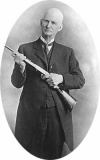 |
| Rifles | Winchester Model 1885 · Winchester Model 1886 · Winchester 1892 · Winchester Model 1894 · Winchester Model 1895 · Remington Model 8 · Remington Model 24 · FN Trombone | |
| Shotguns | Winchester Model 1887 · Winchester Model 1897 · Browning Auto-5/Remington Model 11 · Remington Model 17 · Savage Model 520 · Browning Superposed · Ithaca 37 | |
| Machine guns | Colt-Browning M1895 · Browning M1917 · Browning Automatic Rifle · Browning M1919 · M2 Machine Gun | |
| Cartridges | .25 ACP · .32 ACP · .38 ACP · .380 ACP · .45 ACP · .50 BMG | |
| Handguns | M9 | M11 | MEU(SOC) | Mk 23 | Mk 24 | |
|---|---|---|
| Rifles | Assault and Battle | M16 | Mk 14 | Mk 17 |
| Carbine | HK416 | M4 | Mk 18 | |
| Designated Marksman | DMR | M14 | M39 | Mk 12 | SAM-R | SDM-R | SEAL Recon Rifle | |
| Sniper | M24 | M40 | M107 | M110 | Mk 11 | Mk 15 | |
| Shotguns | M26 | M590 | M870 | M1014 | |
| Submachine guns | MP5N | P90 | |
| Machine guns | M2HB (still!) | M240B | M249 and Mk 46 | Mk 43 | |
| Grenade launchers | M203 | M32 | M320 | M79 | Mk 19 | Mk 47 | |
| Mortars | M120 | M224 | M252 | |
| Rockets | M3 | M72 series | M136 | M141 | M202A1 | Mk 153 | |
| Missiles | FGM-172 | FGM-148 | FIM-92 | |
| Cartridges | 12-gauge | 5.7x28mm | 9x19mm NATO | .45 ACP | 5.56x45mm NATO | 7.62x51mm NATO | .50 BMG (12.7x99mm NATO) | 40x46mm | |
